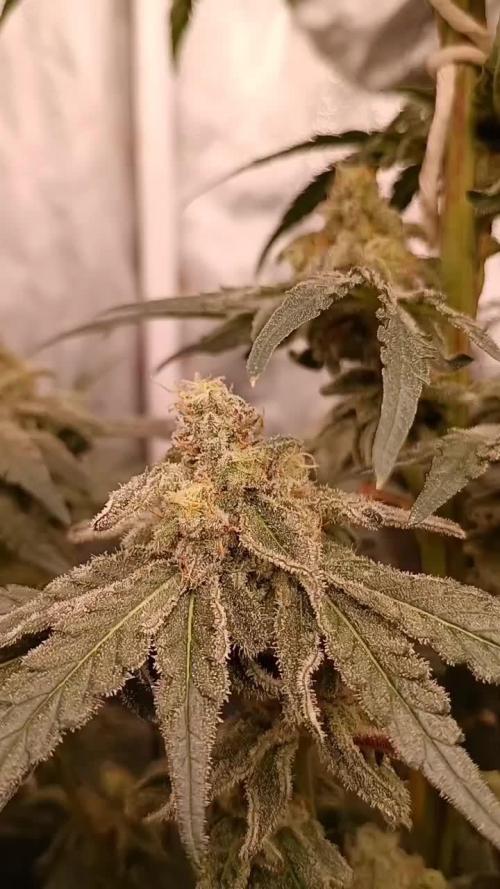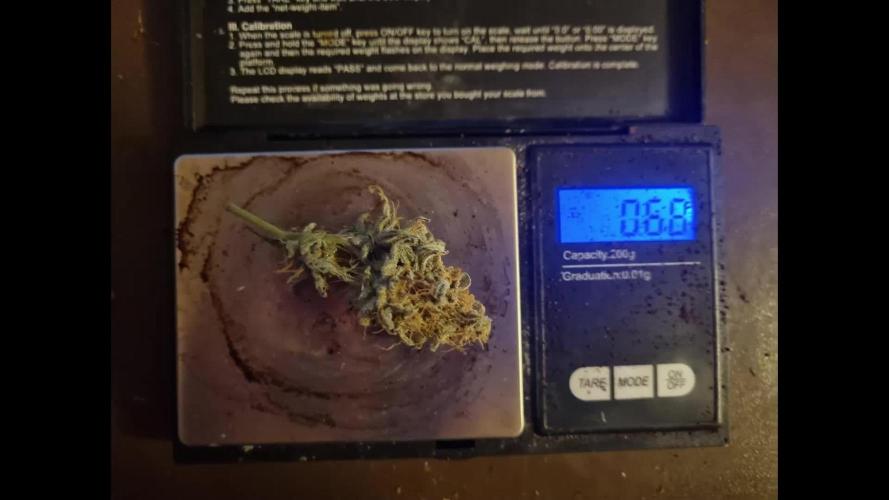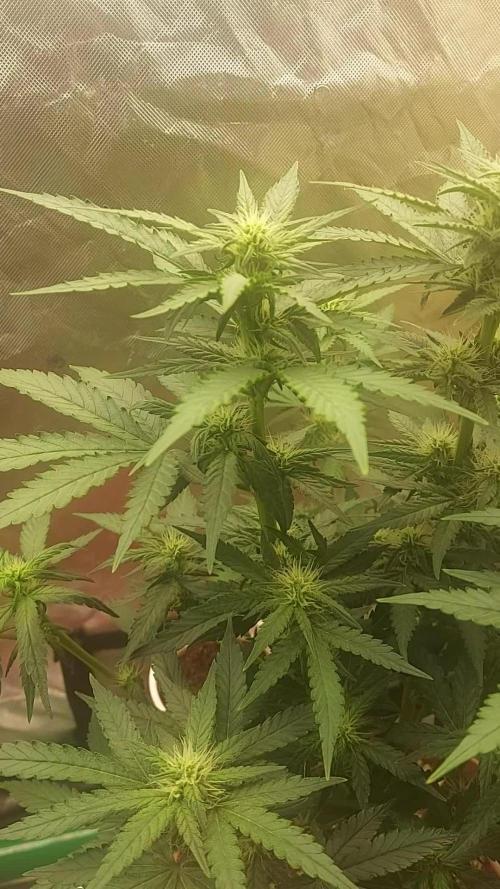The Grow Awards 2026 🏆 

































Likes
2
Share


@goatpharms
Follow
Filing for divorce this week… Mrs Mac is looking way too fine to ignore 😍😅
Despite last week’s 30°C heatwave, the girls didn’t flinch. Temps have eased off now, and there’s zero sign of stress — just happy fattening buds.
PK 13/14 and booster are in the mix (as always, I start as soon as I see bud sites and keep it running till flush). Buds are stacking up beautifully with a solid coat of frost starting to come through.
New Oscillating Cloudray S6 installed
If you’re like me and have gone through multiple crappy fans, the Cloudray S6 Gen 2 is a solid choice — well-built, quiet, powerful, and it can be hooked up to a controller 🌱💚
Likes
299
Share


@Metatronix
Follow
Good day to all my friends and visitors here on GD.
Decided to finally finish this diary, I took my time with his one ;)
Now we cut the second POGP auto plant, the first cut you can find in week 17. The plant from week 17 weighted 660g. wet, this one finished at 1,85kg. wet.
The girls where autoflower but thanks to me starting this grow in cold day temps (14 degree Celsius) the started flower really late, maybe that's also the reason for all my problems with this strain during the grow?!
The two plants where different phenotypes, the smaller one (from Week 17)though small had nice hard flowers, the bigger one as the only plant from four I grew during the growop started foxtailing.
Both of them branched nicely the smell was quite strong and awoul xD like gasoline and something rotten, it smelled so bad i checked a couple times under microscope for any signs of mold in the flower and to my suprise I found nothing.
Thank God later during drying the smell would subdue to a more generic "hazediesel" smell
--------------------------------------------------------------------------------------------------
SE7000 done it's magic with this grow as with all my other grow ops.
For anyone who is interested in obtaining this efficient and affordable light fixture ($ to gram) here's the link:
https://spider-farmer.com/products/spider-farmer-upgraded-se7000-730w-commercial-led-grow-light/
A shout out to SSSC for the gift of genetics: supersativaseedclub.com/
Thank you all for your companionship on this voyage, I hope you enjoyed it at least as much as I did.
Also thank you for this awesome year together here.
Likes
17
Share


@RakonGrow
Follow
Harter ritt diese Dame , alles viel zu schwer das es gleich umknickte beim defolieren .
Hab mal ein getrockneten Bud aus der mitte genommen und Trichom analyse (Videos und Bilder) gemacht . ja viel klar wenig milchig und einige rot . Ergo , zuviel Licht an der Spitze (abstand zum licht viel zu gering) und im Boden zu kalt ist keine gute Kombination .
Likes
5
Share


@most_dope
Follow
This is just for the gorilla zkittlez so far I will probably try to put all 5 on here but started 2 about 45 days apart from each other and the 5th seed about 3 weeks after the 2nd round. The 5th seed died from transplant shock (won’t be transplanting autos anymore) but the 2nd round of 2 plants just started flowering. I got 85 grams from the zkittlez and 60 grams from the afghan kush after drying. Not great but I’m happy it’s smokeable and smells/ tastes good. starting 2 bloody skunk today (5/11) because the gorilla cookies never germinated unfortunately :( . all out of seeds now so i will be maknig an order this week. still have 2 more strains to figure out when flowering kicks in more tho so that will be my fun for the next 1-2 months lol
Likes
3
Share


@captaincondor
Follow
sadly some of the other seedlings didn't make it though i am blaming myself on this occasion as the coco i used was too hot for them . I checked the ec and it was way too high around 2 so its no wonder I've had issues.
Likes
9
Share


@newenglandgrowers
Follow
Continuing LST and also did a super light defoliation only took off some of the bottom leaves that were still touching the coco. Also switched on the bloom switch as well at the end of the week. Also sprinkled a bit of Diatomaceous Earth on the coco coir especially at the base of the plant, and also sprinkled a bit on the leaves as well although that wasn't intentional
Likes
9
Share


@Hypnogrow
Follow
Defoliated week two of flower. King tut showed preflower within three days, alien tech has taken about a week longer. Because I had autos in the tent I let these two photos veg about a month longer plus I took clones from both plants so let them recover a few weeks from that as well. Three alien tech rooted and one king tut clone have now rooted. I've never cloned before so think I will do better next time. We installed a second mars hydro tent with two fc3000 lights so we have a 4 by 8 dedicated veg/auto tent. This five by five gorilla tent is now the flower tent for photos. I could probably fill the tent with a single king tut plant easy. The king Tut has gotten huge! Alien tech put a bit of stretch on but is staying more compact and bushy. These plants have been through multiple toppings at a time and lst mainly through my own ignorance but they have pulled through like champs with all the stress. In Cocodelphia which I highly recommend, auto water with hydrolock system 4 times a day for 4 minutes at 550 ppm 6.0 to 6.1 ph dtw. King tut is a little nutrient sensitive which i think is the auto genetics. I could push more ppms but she has a tiny tip of nutrient burn so not pushing it for another week then will up ppms according to general hydroponics schedule from cocoforcannabis. If your new at dtw coco follow their schedule it will get you to the end of your first grow easily.
Likes
22
Share


@Changman
Follow
What a surprising week this has been. Unfortunately our Elixir CBD instead of producing a healthy 20 to 30 grams dry yeild has seemed to know only expect to give us 5 grams if we lucky😞.Our Pineapple Express#2 is growing expectionally well standing at 42CM all she needs is some training hopefully its not too late.Our Blue Cheese is 7CM and Granddaddy black is 3CM.Our GSC is now about 12CM and our Purple Kush is about 17CM and Hindu Kush about 19CM they have all began training.
Likes
18
Share


@hanzSour
Follow
62days of flower
sticky frosty buds
purple since the 6th flowerweek
branches must be supported
frech buds smells sweet and fruity
she drinks a lot
gets big and bushy
10 days dry room(19c/60%)
trim only with gloves
scissors glued
Likes
25
Share


@Organic_G
Follow
Die Ladys haben sich gut gefangen und erholt. War zwei Wochen in Urlaub, mein Kollege war nur zwei mal gießen und die wachsen super… bisher scheint die Topfgröße und das Volumen von 300L + gut zu laufen 😎 bin mehr als gehyped wenn die fertig sind… denke mache morgen ein scrog Netz drüber und breite die maximal aus bevor es in die Blüte geht
Likes
31
Share


@THCpapa
Follow
Week 13 in the garden, and it's been a week of contemplation and admiration. Despite my initial plan to flip the plants, I decided to give them another week in vegetation. It's like I'm sculpting a masterpiece, carefully grooming the plants into a perfect botanical sculpture.
Working with my plants feels like art – it requires skill, love, dedication, and a sense of playing God. As I look at the tent, I can't help but feel a sense of pride and joy. These green beauties are turning out amazing, and I'm filled with overwhelming happiness whenever I get the chance to speak to people about them and show them off.
But the time has come to take the next step in their journey. They're being flipped this week for sure, ready to embark on the next chapter of their growth. It's bittersweet, but I know it's all part of the magical process of growing these wonderful plants. Here's to Week 13 – a week of artistry, joy, and the promise of new beginnings. 🌿🎨
Likes
9
Share


@Siriuz
Follow
Ok guys so she was bushy again and so we did defoliation again.
You can see the difference and then after that started flowering even more
Plus the fact we are increasing the amount of molasses added to the soil plus the floranova bloom nutes.
They are very thirsty girls, taking around 1.5-2lts per 48 hrs
So almost like a 1 liter per 24 hrs
Very good SoG to make them feel even more comfortable
Going to change schedule from 24/0 to 19/5 and see if they evolve!
Thinking about adding some humus to the soil as well, other than that they have been under good conditions
Temp is steady at day time around 24C top and night time is 18-19C minimum
RH around 45-60%
Mostly 45% control environment with AC
Cant wait to see big colas coming soon!
Have fun enjoy the videos!
Likes
17
Share


@CampaCavallo
Follow
È stata una bella esperienza cannabica far crescere la bella RUNTZ assieme a tutti i fratelli growers di GROWDIARIES.COM!
La RUNTZ è una dolce ragazza che ci affascina con i suoi bei colori e ci conquista con i suoi dolci sapori💓😋
Likes
5
Share


@Mr_Bud_Grower
Follow
Welcome
I was wrong to defoliate in the fifth week, the same week I sent them to bloom
Finally begin to bloom, after a week at 12/12 where unfortunately they have vegetated again 😅
Likes
113
Share


@PEAKYPLANTERS
Follow
gentlemen .... start dancing by flushing .....
I have had many difficulties in the last few weeks .... one of these is too hot ... but my girls have hexagonal balls and go on their way!
prosperous and abundant crops at all ... see you around
Likes
446
Share


@Metatronix
Follow
Hello to you my dear friends and visitors 👋I appreciate you guys visiting and all the likes 😇
Trichomes on the Killer Kush girls ...are mostly milky with a couple transparent mostly on KK#4 and some amber is getting through to, so with all probability i will flush and go dark mode somewhere this thursday or friday (i'll keep you guys updated).
I did set the SE 7000 to 630 Watt for about a week now as i read that it stimulates the plant to grow more bud...here the sorce: https://growlightmeter.com/lighting-requirements-of-cannabis-over-the-full-grow-cycle/
Here are the transcripts of how my week did go through:
05.09. I add:
Canna Cal Mag: 53ml.
Canna PK 13/14: 33ml.
PH: 6,3
EC: 2,6
06.09. I add Jungle Indabox:
A: 27ml.
B: 75ml.
M: 55ml.
Ata Bloombastic: 60ml.
Canna Cal Mag: 85ml.
Hesi Powerzyme: 100ml.
PH: 6,3
EC: 3,2
09.09. I add Jungle Indabox:
A: 25ml.
B: 70ml.
M: 50ml.
Canna Cal Mag: 78ml.
Ata Bloombastic: 80ml.
Ata Clean: 7ml.
Ph: 6,15
EC: 3,8
That's it for this week I hope everyone had as good a week as i did, hopefully see you next week 😅 all the best to you my friends and keep it growing 💪
Likes
37
Share


@DogDoctorOfficial
Follow
🌱 Week 2: Mutant Magic in Full Swing! 🌱
Hey Grow Fam! Another week, another step forward in the adventure with these Mentha de Croco beauties. Week 2 has been nothing short of fascinating—the variety in leaf shapes is absolutely mesmerizing. These tiny mutants are already showing their unique personality, and I’m loving every second of watching them grow! 🌿✨
Tent Conditions: Consistency is Key
The setup remains the same as last week, keeping these little ones in the perfect environment to thrive:
• Temperature: Stable, warm conditions for steady growth.
• Humidity: Maintaining high RH ensures they’re still enjoying tropical vibes as their root systems develop.
• Lighting: The Future of Grow (FOG) LED at 200 PPFD continues to deliver just the right amount of light to keep the plants growing compact and strong.
Nutrition: Introducing the Organic-Mineral Boost 🌿
This week, I started feeding the plants with the incredible Aptus Holland organic-mineral line. It’s been a game-changer, and here’s why I love it:
What’s Organic-Mineral Nutrition?
• Combines the benefits of organic matter (microbial health and soil vitality) with the efficiency of mineral nutrients (direct uptake by plants).
• Supports balanced, steady growth while boosting plant resilience.
This Week’s Feeding Schedule:
• Regulator (0.15 ml/L): A silica-based product that strengthens plant structure and helps regulate stress, ensuring the plants stay strong and sturdy.
• CalMag Boost (0.25 ml/L): Calcium and magnesium are essential for cell wall development and chlorophyll production, supporting lush, vibrant growth.
• All-in-One Liquid (1 ml/L): A comprehensive blend that delivers all the essential nutrients in one easy feed, perfect for these little mutants finding their stride.
• Start Booster (0.25 ml/L): Packed with root-stimulating microbes and nutrients, this product ensures strong root development and prepares the plants for explosive growth in the coming weeks.
Why Aptus?
I’ve been a huge fan of Aptus Holland because their line truly focuses on building strong, healthy plants from the ground up. The results speak for themselves—happy plants, explosive growth, and vibrant health at every stage. true believer here and way before being sponsored by them .
Mutant Leaf Love: Celebrating the Unique 🌿
The highlight of this week has to be the unique leaf patterns these plants are developing. Each one seems to have its own story to tell—serrated edges, funky symmetry, and a whole spectrum of textures. They’re tiny but mighty, and it’s so exciting to see the potential of these genetics from Terpyz Mutant Genetics come to life.
Mutants always bring surprises, and it’s a beautiful reminder that diversity is what makes this journey so rewarding.
Reflections & Tips for Fellow Growers 💡
💚 Feed Lightly, Grow Strong: For young plants, keep your feed gentle to avoid overloading them. Start slow and adjust as they grow.
🌱 Celebrate Differences: Each plant will grow at its own pace, and unique traits are part of the magic. Patience is key!
💧 Stay Consistent: The foundation you build in these early weeks sets the tone for the entire grow. Stable conditions = happy plants.
Shoutouts & Grower’s Love 💚
Big thank you to @Terpyz Genetics for these funky mutant seeds, @Aptus Holland for their stellar nutrition lineup, @Future of Grow for the lighting that keeps these beauties thriving, @Pro Mix Soil for the best one i have encountered so far and @Grow Diaries for being an amazing platform to share this journey.
And a HUGE shoutout to all of you—followers, growers, or just curious passersby! Your love, support, and shared passion for growing make this experience truly special.
Stay tuned for more mutant magic in Week 3. Let’s grow, let’s grow, let’s grow! 🌟
Genetics - Mentha De Croco
https://terpyz.eu/products/menta-de-croco-fern-type?_pos=1&_sid=e9237cbcb&_ss=r
DogDoctorOfficial Discount Codes @ terpyz.eu - DOCTOR 15% off
Nutrition - @aptusholland
https://aptus-holland.com/
Led Power @ F.O.G. Future Of Grow
https://www.thefuturofgrow.com/en/online-store/BLACK-SERIES-600-p489093171
Controls @ TrolMaster
https://www.trolmaster.eu/tent-x
As always thank you all for stopping by, for the love and for it all , this journey of mine wold just not be the same without you guys, the love and support is very much appreciloved and i fell honored with you all in my life
With true love comes happiness Always believe in your self and always do things expecting nothing and with an open heart , be a giver and the universe will give back to you in ways you could not even imagine so
Growers Love To you All 💚






























